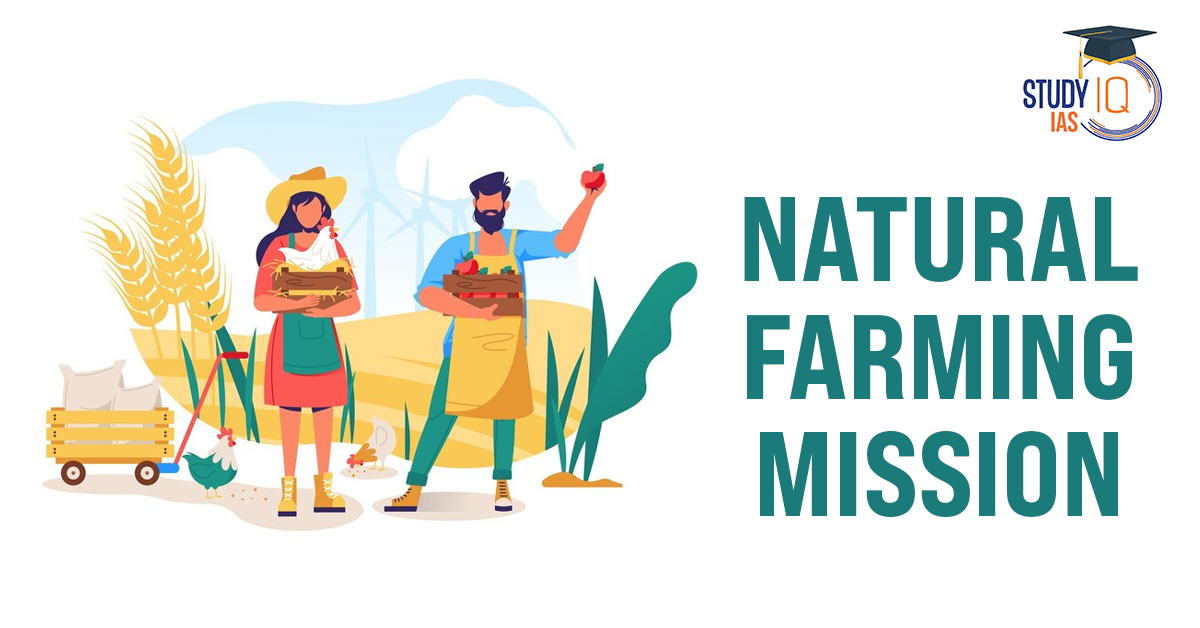Table of Contents
Context: The Centre has issued guidelines for its recently launched National Mission on Natural Farming (NMNF) as a centrally sponsored scheme under the Ministry of Agriculture and Farmers’ Welfare.
National Mission on Natural Farming (NMNF) Scheme
The Ministry of Agriculture and Farmers’ Welfare has launched NMNF as a centrally sponsored scheme to promote natural farming in mission mode. NMNF aims at promoting NF practices for providing safe & nutritious food for all.
Salient Features of NMNF Scheme
- The scheme has a total outlay of Rs.2481 crore (Government of India share – Rs.1584 crore; State share – Rs.897 crore) till the 15th Finance Commission (2025-26).
- In the next two years, natural farming will be implemented in 15,000 clusters in Gram Panchayats willing to adopt Natural farming and reach one crore farmers in an area of 7.5 lakh hectare area.
- Preference will be given to areas having prevalence of practising NF farmers, SRLM / PACS / FPOs, etc.
- Need-based 10,000 Bio-input Resource Centres (BRCs) will be set-up to provide easy availability and accessibility to ready-to-use NF inputs for farmers.
- 2000 Natural Farming Demonstration Farms to be established at Kisan Vikas Kendras, Agricultural Universities and farmers’ fields. Willing farmers will be trained in natural farming at these demonstration farms.
- Easy and simple certification system for natural farming products.
- Dedicated common branding for natural farming farming products.
- 18.75 lakh trained willing farmers will prepare inputs like Jeevamrit, Beejamrit, etc. by using their livestock or procure from BRCs.
- 30,000 Krishi Sakhis will be deployed for awareness generation, mobilisation and handholding of willing farmers in the clusters.
- Real time geo-tagged & reference monitoring of implementation of the scheme through online porta.
- Students will be trained in Natural Farming through the Rural Agricultural Work Experience (RAWE) program and dedicated courses on natural farming will be introduced at undergraduate and post-graduate level.
Identified Priority Areas for implementing NMNF
- Namami Gange regions within a 5 kilometre corridor along the Ganga river
- Districts on the banks of major river bodies as decided by the state
- Districts with high fertilizer input sale in states
- Districts with low fertiliser input sale in states
- Districts with strong State Rural Livelihood Missions, Primary Agricultural Credit Societies, Farmer Producer Organizations or other Community-Based Organizations
Natural Farming
It is a unique chemical-free farming method that is considered to be an agroecology-based diversified farming system, which integrates crops, trees and livestock, allowing functional biodiversity.
Characteristics of Natural Farming
- Avoids the use of synthetic fertilizers, pesticides, or herbicides.
- Promotes cultivation of 15-20 diverse crops with a living root, present year-round.
- Requires minimal human intervention in farming practices.
- Encourages the use of native or traditional seeds.
- Incorporates animals into the farming system, utilizing their dung and urine as resources.
- Promotes the use of various organic residues for soil enrichment.
- Relies on good agronomic practices instead of chemical pesticides or herbicides.
- Utilizes bio-stimulants and other natural resources available locally to support farming.
- Focuses on creating an environment for soil microorganisms to thrive, ensuring independent soil fertility.
- Relies on air, water, and sunlight for 98-98.5% of plant nutrients, with the remaining nutrients derived naturally from soil.
Pillars of Natural Farming
| Pillars | Description |
| Beejamrit | Microbial coating of seeds with a mixture of cow urine and cow dung. |
| Jeevamrit | Soil microbial enhancement using cow dung, cow urine, and jaggery. |
| Mulching | Covering the soil with crops or crop residues to retain moisture and reduce erosion. |
| Waaphasa | Building soil humus to increase aeration and improve soil health |
| Note: In addition, ZBNF includes three methods of insect and pest management: Agniastra, Brahmastra and Neemastra (all different preparations using cow urine, cow dung, tobacco, fruits, green chilli, garlic, and neem). | |
Benefits of Natural Farming
- Improve Yield: Farmers practising Natural Farming reported comparable or, in some cases, higher yields per harvest compared to conventional farming.
- Ensures Better Health: Natural Farming avoids synthetic chemicals, eliminating health risks and producing nutrient-dense food with superior health benefits.
- Environment Conservation: Natural Farming ensures better soil biology, improved agrobiodiversity, and judicious water use with much smaller carbon and nitrogen footprints.
- Increased Farmers’ Income: Natural Farming aims to make farming viable and aspirational by increasing the net incomes of farmers on account of cost reduction, reduced risks, similar yields, and income from intercropping.
- E.g., A study by Andhra University, surveying over 3,500 natural and conventional farms, found that the average net returns from natural farming were 50% greater than those from conventional farming.
- Employment Generation: Natural Farming generates employment on account of natural farming input enterprises, value addition, marketing in local areas, etc.
- Reduced Water Consumption: By working with diverse crops that help each other and cover the soil to prevent unnecessary water loss through evaporation, Natural Farming optimizes the amount of ‘crop per drop.’
- Minimized Cost of Production: Natural Farming aims to drastically cut production costs by encouraging farmers to prepare essential biological inputs using on-farm, natural and home-grown resources.
- E.g., A panel survey of 260 farm households which were surveyed in 2018-19 and 2019-20, found that natural farming reduced the dependence on credit,
- Rejuvenates Soil Health: The most immediate impact of Natural Farming is on the biology of soil—on microbes and other living organisms, such as earthworms.
- Livestock Sustainability: The integration of livestock in the farming system plays an essential role in Natural Farming and helps restore the ecosystem.
Challenges in Adoption of Natural Farming
- Convincing the Scientific Community: Without evidence from research institutions, it will be challenging to gain broad consensus, leaving stakeholders and farmers sceptical about the effectiveness of natural farming.
- Adoption by Large-Scale Farms: Natural farming demands significant labour for monitoring fields and preparing inputs, making it less practical for large farms compared to smallholder operations.
- Suitability for High-Input Monocropping Areas: Regions practising monocropping, like the Indo-Gangetic Plains, may struggle with natural farming due to nutrient-specific demands and potential yield reductions.
- Reduced Mechanization Opportunities: The intercropping or mixed cropping required in natural farming limits the use of large-scale farm machinery, affecting efficiency and scalability.
- Continuous Yield Improvement: The lack of improved seeds in natural farming may result in yield stagnation, discouraging farmers from sustained adoption.
- Economic Impact on the Crop Protection Industry: India’s crop protection industry, valued at ₹18,000 crores, faces potential disruption as the promotion of natural farming could jeopardize its business ecosystem.
Way Forward
- Enhance Research and Development: It is important to conduct systematic studies at ICAR institutes and agricultural universities to address critical questions on Natural Farming, such as the effectiveness of different inputs, application methods, and their impact across diverse agroclimatic conditions.
- Comprehensive Impact Studies: The socio-economic and environmental effects of Natural Farming, including carbon footprint reduction, soil health improvement, cost savings on chemical fertilizers, should be evaluated.
- Develop Certification Mechanisms: Proper certification systems like Participatory Guarantee Systems (PGS) to ensure premium pricing for chemical-free Natural Farming produce, creating a distinct market segment, should be established.
- Promote Farmer Producer Organizations (FPOs): Support FPOs that exclusively advocate Natural Farming with financial incentives for monitoring, value addition, and marketing of Natural Farming produce.
- Focus on Region-Specific Adoption: It is important to promote Natural Farming in regions where intercropping is prevalent or feasible and smallholder farmers can manage farms with family labour. For high-input monocropping areas, the adaptability and profitability to ensure successful implementation should be assessed.
| Government Schemes Related Links | |
| Credit Guarantee Scheme for MSME | Small Savings Schemes |
| One Nation One Subscription (ONOS) | PM VIKAS Scheme |
| PLI Scheme | Make in India |


 Accredited Social Health Activists (ASHA...
Accredited Social Health Activists (ASHA...
 World’s 1st Unique Q-Shield Platform a...
World’s 1st Unique Q-Shield Platform a...
 New Phase of Operation Chakra to Combat ...
New Phase of Operation Chakra to Combat ...





















